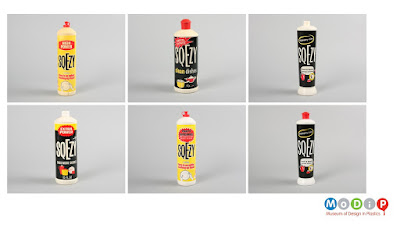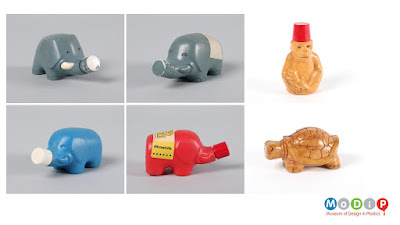In March, MoDiP was invited by the BPF to provide a short series of webinars about classic design inspired by objects in the MoDiP collection.
The object or objects that have inspired the last talk are the Sqezy bottle created by Cascelloid a division of BXL. MoDiP has 19 different bottles in the MoDiP collection which were donated to the us via an employee of BXL along with other objects, and archival documentation including a great resource of photographs showing products, buildings, and equipment. I will share some of these with you as we go along. This is going to be an image or object heavy post which is pertinent of the mass-produced item of packaging and the stories behind them (click on the images to make them bigger). The image below is from an exhibition, Spotlight on 2…, which highlighted some manufacturers and designers who are significant in the story of plastics.
In the image below, I have attempted to create a Cascelloid family tree of sorts to help us understand the story of the company.
Cascelloid Ltd was founded by Alfred Edward Pallett in 1919 in Leicester and were makers of plastics toys. The company was bought by British Xylonite in 1931.
Toy manufacture stopped during the Second World War and Cascelloid undertook a great variety of work to help the war effort including the manufacture of parachutes, jettison fuel tanks and cartridge clips. In the immediate post-war period the manufacture of plastic toys was still the company’s major activity but it was planned to broaden the field by introducing general moulding and to specialise in plastic packaging for industry.
After the War Cascelloid wrote to the designer Bill Pugh to invite him for an interview, but he replied saying he was too busy and could not come. Cascelloid’s Managing Director at the time, Henry Senior persisted and Pugh was secured by the company. At the same time the company acquired an imported blow moulding machine. In 1949, Pugh designed the first novelty shaped bottle, a pale pink teddy-bear with a screw-top for Vinolia baby powder. He modelled it by hand in clay, then cast it into plaster for mould-making. The squeeze lemon, marketed now as Jif, began life as a wooden core carved by Pugh and covered painstakingly with fresh lemon peel which he cast into a plaster mould, experimenting until he had it just right. Which shows the lengths that he, as a designer and Cascelloid as a manufacturer would go to get the effects that they wanted. Cascelloid then split into two in 1965, with Pugh becoming Director of Design, Research and Development at Palitoy with toys as a focus, and Cascelloid continuing to make bottles.
The very first squeeze-to-use bottle was introduced in the late 1950s and had a metal top and bottom, and a flexible tube body. The design was instantly successful. As you can see many different products were contained within these tubes and so they needed to have very clear graphics to make sure the ant powder was not mixed up with the table salt!
Cascelloid were also making polythene collapsible squeeze tubes. They started production in 1954 in small quantities, but didn’t enjoy the immediate success that the other bottles did, however by 1965 a whole factory at Stamford was given over to their production.
Returning to the original Sqezy bottle.
The containers with the metal ends were known as Cascapak and were sold as being able to withstand 200,000 pressures and releases. As you can see in the image below, both ends could have a different metal fixture depending on the product’s needs. They were promoted to brands as being able to keep their shape and so keep the brand name clearly legible and undistorted. They were promoted as having Poster-like quality, that was eye-catching and had ‘shelf appeal’ to the consumer. The bold print in up to 4 colours was clean and crisp. Polythene offered a key on the surface of the material on to which fine detail could be achieved with the contemporary printing techniques available. The indelible inks that were used didn’t crack, flake or rub off.
This image shows a brochure which came to us as part of the BXL archive and is fascinating as it asks their customers – the producers of the food, pharmaceuticals, cosmetics, and household products to ‘Consider the economies in transport costs’ that these lightweight and unbreakable bottles provide.
Next are a series of images which are not the best of quality – they are scans of photocopies that are part of the BXL archive, and unfortunately, we don’t have the original images.
Firstly, the extruded tube for the sleeve is cut to length. Different sized containers could be achieved by lengthening a standard diameter tool, meaning no retooling is required. The lady in the right-hand image is attaching the one of the end plates before the tube is printed. For powder content the tube could be filled before adding the top plate.
The below images show the printing process. It looks like the top plates are already in place on the tubes as you can see on the conveyor belt in the centre but the bottom plates are not.
The next set of images were labelled as ‘final spin, test, and pack’, the spin referring to the screwing in place of the metal end plate.
Housework was hard work so the Sqezy product was advertised as making it easier to do the washing up. Some people think that the phrase Easy Peasey Lemon Squeezy comes from the Sqezy advert, but it might be a misremembering of the strap line shown here ‘It’s easy with Sqezy!’
The image below, which has been recently acquired by MoDiP shows a page out of an Ideal Home magazine from 1960.
‘Quick as a wink away from the sink.’ This is aimed at the housewife.
What is fascinating about both of these adverts is the fact that the bottle of Sqezy is shown with its print upside down to make it look more attractive on the page. Of course, with the introduction of the silicone valve we are used to seeing products in squeeze to use bottles with their lids at the bottom but at this time the bottle would have been firmly placed the right way up to avoid leakage.
These metal-ended bottles were a huge success from when they were launched in 1956/7. However, over time the price of polythene was substantially reduced and from that point suppliers of detergents wanted blow moulded polythene bottles. This is a blank example in the MoDiP collection which has a blow moulded base and a metal top, like a hybrid bottle – whether this is easing the consumer or the manufacturer towards the wholey plastic bottle I am not quite sure.
I thought I would take the opportunity to show a range of Sqezy bottles in the collection. These ones date from the 1960s. As we run through the next couple of decades we will see that the strength of the branding is clear. Yet, the bottle shape becomes more generic.
These bottles date from the 1970s…
…. And finally, the 1980s.
Below are some toys that were made under the Cascelloid of Palitoy name.

Here is a range of shaped bottles made by Cascelloid for HAX and designed by Edward Hack. The fish shaped bottle would have contained lemon juice to put on fish rather than fish flavoured syrup.
And here we have a small group of wooden models for Zoo glue. The red elephant bottle is the final piece.
Despite the fact that the packaging of liquid is necessary, inevitably the Sqezy bottle has proved to be an indicator of the longevity of plastics in the oceans. These images have been accompanied by the headlines:
- A plastic washing-up liquid bottle that is at least 47 years old has been found on an Isle of Man beach, just days after a similar find in the UK.
- Bottle’s 50-year swim shows scale of plastic crisis.
- A 70-year-old plastic bottle which contained Britain's first washing up liquid has been found in Stamford.
These should be indicators of the hidden value of plastics, and the need to keep materials in the system through recycling. Of course, at the time these bottles were in use the idea of recycling was in its infancy, and the recycling of plastics products was limited.
Louise Dennis, Curator of MoDiP


















thnks
ReplyDelete